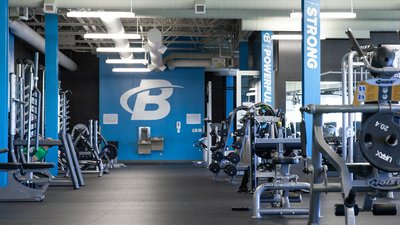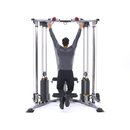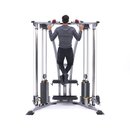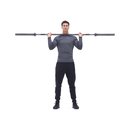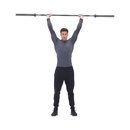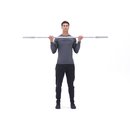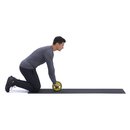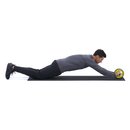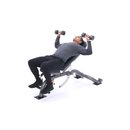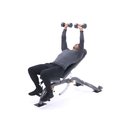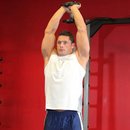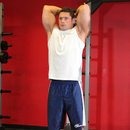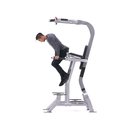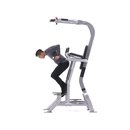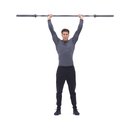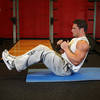TOPIC: What Is The Best Full-Body Workout For Muscle Gain?
The Question:
There has been debate as to whether full-body workouts can help one gain as much muscle as 3, 4 or 5-day splits.
What is the best full-body workout for muscle gain? Be specific.
How does a full-body workout stack up to the standard 3, 4 and 5-day splits?
What are the benefits of a full-body workout routine?
What are the disadvantages?
Bonus Question
: Have you ever used a full-body workout routine? If so, how were the results?
Show off your knowledge to the world!
The Winners:
- olinerules87 View Profile
- PumpingSteel View Profile
- EAGLES56
Prizes:
1st Place - olinerules87
View This Author's BodySpace Here.
Introduction
Start a conversation in the gym or on an Internet forum about whether full-body workouts are better than training splits and you are sure to start a huge debate with die-hard proponents on each side of the argument.
So which is better? The truth is neither training style is necessarily better than the other. Whether full-body workouts should be used is specific to each individual's personal response to that training style. For some people, full-body workouts are the best option leading to big increases in size and strength for its users, while others respond better to split training programs.
One should experiment with both training techniques to determine which training style their body best responds to. Knowing which training style works best for you will give you better results faster!
Workout
What Is The Best Full-Body Workout For Muscle Gain? Be Specific.
The best full-body workout program for muscle gain will use mostly compound exercises because they work many muscles at once and give the most "bang for the buck."
On this program, you will workout 3 times per week with one days rest between each workout. The rep schemes in this program will be kept between a total volume of 24-50 per exercise (volume = sets X reps). A total volume of 24-50 is great for both increasing strength and promoting hypertrophy.
A different rep scheme will be used each workout of the week. Rest periods between sets should be kept between 1-and-2 minutes. Higher rep schemes will have slightly longer rest periods and lower rep schemes will have less rest time between sets.
Try to avoid training to failure while working out on full-body programs because training to failure will require more recovery time. One should strive to increase weights lifted or reps performed each week to continue seeing progression.
Each workout will contain one exercise per major muscle group and two isolation exercises of your choice. One compound exercise should be chosen to work the lower body muscles, upper body pushing muscles and upper body pulling exercises. There should also be one shoulder exercise.
"One Should Strive To Increase Weights Lifted Or Reps Performed Each Week To Continue Seeing Progression. "
Because the abdominals, calves, triceps and biceps will get worked in the big compound exercises you choose, they do not need to be directly stimulated each day. Each workout chose two of these smaller muscles and perform one exercise for each of the 2 you selected.
Choose one exercise for each of the groups below for each workout (the below exercises are suggestions only and you are not limited to just these movements):
Compound Upper Body Push
- Bench Press (Barbell or Dumbbell)
- Incline Bench Press (Barbell or Dumbbell)
- Decline Bench Press (Barbell or Dumbbell)
- Dips
- Pushups
Compound Upper Body Pulling
- Pullups
- Chin-ups
- Lat Pulldowns
- Bent Over Rows
- Cable Rows
- Other Row Variations
Compound Lower Body
- Squats
- Front Squats
- Hack Squats
- Deadlifts
- Straight Leg Deadlifts
- Romanian Deadlifts
- Lunges
- Step Ups
Shoulder Exercise
- Military Press
- Push Press
- Upright Rows
- Lateral Raises
- External Rotations
- Power Cleans
- Shrugs
One Isolation Exercise For 2 Muscles Of Your Choice
- Biceps
- Triceps
- Abs
- Calves
Sample Program
Compare
How Does A Full-Body Workout Stack Up To The Standard 3, 4 And 5 Day Splits?
A full-body workout can more than hold its own against a split training program. For many people, doing full-body workouts can be better for total body growth than a traditional bodybuilding split routine. Because every muscle gets worked multiple times per week there are more opportunities for growth while on a total body training program, which allows many people to grow more from this training style.
While many people may argue that full-body workouts ignore many smaller muscles because less isolation exercises are used in this style of training, it is possible to provide adequate stimulation for growth for these smaller muscles using mostly compound exercises and a few isolation movements.
Benefits
What Are The Benefits Of A Full-Body Workout Routine?
Higher training frequency allows for more growth phases.
Each muscle group is fresh when you work it because there is no accumulated fatigue from performing several exercises in the same day for the same muscle group. For example, in a training split program you may perform 3 chest exercises in one workout. By the third exercise, your chest will have accumulated a significant amount of fatigue and you would no longer be able to lift near maximum weights.
In a full-body workout only one exercise is performed per body part so each muscle is fresh and you can lift heavier weights each workout.
Full-body workouts are great for beginners.
Athletes may better benefit from total body training because of the increased total body conditioning needed for full-body workouts.
More motor units are stimulated per workout than in training splits.
Many people will undertrain their muscles while on splits because a muscle usually doesn't need an entire week to recover. Because each muscle is worked multiple times per week while on a full-body workout there is less chance of undertraining a muscle.
Less deep soreness allows one to participate in other physical activities such as sports without being held back by their muscle soreness (try playing sports after a leg day on a body part split program and you will know what I mean!).
Disdvantages
What Are The Disadvantages?
People with lower recovery abilities may be more vulnerable to overtraining on full-body workouts because of shorter recovery periods.
Most full-body workout programs only allow you to lift 3-or-4 times a week.
Splits allow for weak points to be more easily addressed and corrected than full-body workouts.
Less localized increase in muscle endurance while performing total body workouts compared to split training.
Some training techniques such as drop sets, rest paused sets and forced reps cannot be used because the body can't recover fully from those intense techniques with the shorter recovery times of full-body.
Bonus Question
Have You Ever Used A Full-Body Workout Routine? If So, How Were The Results?
I have used full-body workout routines with great results. When I began lifting for football in the 9th grade I started using full-body workouts and gained 70 pounds in the next 3 years. Since then I have experimented with many other training styles including traditional splits, high volume programs, low volume high intensity programs and upper-lower splits.
After trying all of these various training styles I have returned to training with full-body workouts because my body responds best to the higher frequency that I am able to train with while of total body training programs.
References
Waterbury, Chad. "The Set/Rep Bible." https://www.t-nation.com/findArticle.do?article=05-091-training
Henriques, Tim. "TBT vs. Split: An Analysis." https://www.t-nation.com/findArticle.do?article=06-207-training
2nd Place - PumpingSteel
View This Author's BodySpace Here.
Workout
What Is The Best Full-Body Workout For Muscle Gain? Be Specific.
There are a lot of great full-body workouts out there. If done correctly, full-body workouts can allow you to gain as much muscle as split, if not more. In my opinion, the best full-body workout for muscle gain would be Hypertrophy Specific-Training (HST) by Bryan Haycock.
Hypertrophy Specific-Training (HST) By Bryan Haycock.
Rep Scheme
First step is to choose your rep scheme. If this is your first time doing HST, you should do the tradition 15's, 10's and 5's. This means for two weeks, you do 15 repetitions, the next two weeks, you do 10 repetitions, and then the next two weeks, you do 5 repetitions. You can also choose 12's, 8's and 4's. It's really up to you, but I recommend 15's, 10's and 5's for the beginners.
Choosing Exercises
For exercises, you can pick 8-12 exercises, depending on your recovery. I recommend 8 exercises - 1 exercise for each body part. Number one rule is: choose compound movement over isolation movement, since compound movement allows you to move most weight and recruits a lot more muscle than isolation exercises.
8 Exercise Example:
- Legs - Squat
- Chest - Bench Press
- Back - Barbell Row
- Lower Back - Hyperextension/Deadlift
- Tricep - Dips
- Bicep - Chin-Up/Dumbbell Curls
- Calves - Calf Press
- Ab - Cable Crunches
Finding Out Your Max
Now you need to find out your max for each set. Reason for this is, you will be performing your maxes every two weeks. So on Monday, go to the gym and find out the max for your 15s. Then on Wednesday, find out your max for 10s. Then on Friday, find out your max for 5s.
Strategic Deconditioning
After you find out your max's, you need to take 9-14 days of break. When I say break, I don't mean eat like sh!t, go get drunk or high. I mean eat properly to save as much muscle as you can. You can do cardio few times a week, but do not, DO NOT do bodyweight exercises or any kind of exercises. The point for this is to reset your muscles, when you reached your plateau, so it can start growing again.
Frequency And Weight Load
You can workout three times per week, or six times per week, doing upper and lower separately. I recommend doing three times per week for beginners. For weight, here's the thing: you don't always use heavy weight. Actually, most of them will be light. For first to second week, you will use increments that will allow you to reach your 15 repetition max.
For example, let's say your bench press is 100lb.
1st week:
- 1st workout- 50lb
- 2nd workout- 60lb
- 3rd workout- 70lb
2nd week:
- 4th workout- 80lb
- 5th workout- 90lb
- 6th workout- 100lb (your 15RM)
This is just an example, you can do any weight increments, such as 5 pound.
Volume
For volume, it's important so you don't overdo it. Volume should be measured by total repetition. For 15s, you can do one set each exercise, for 10s you can do two sets each exercise, then for 5s you can do three sets for each exercise.
So the total volume would be:
- 15's = 1x15 = 15
- 10's = 2x10 = 20
- 5's = 3x5 = 15
It is really up to the total reps you perform, and how you feel.
Exercise Alternating
You don't really need to alternate exercises, but a lot of people on HST forum prefer to alternate squatand deadlift, instead of having them in the same workout. They believe its too much pressure on lower back. I disagree, but it's really up to your recovery rate.
This is just an outline for HST. If you want more information, go to their official website or private message me.
Benefits
What Are The Benefits Of A Full-Body Workout Routine?
There are a lot of benefits of full-body workout. These are:
Save Time
Some split-body routines can have you do 5 days a week routines. For an effective full-body routine you only need 3 days a week; less than one hour a day. What people don't realize, is that people need time to recover, and people can actually benefit from rest days, while working out 7 times a week can actually hurt your gains.
Greater Frequency
Depending on your volume, diet, and recovery, you will be able to work your muscles up to three-times per week. The reason is, that volume is separated over the weeks. For example, if I do two sets for chest on Monday, then I do another two sets for chest on Wednesday, and another two sets for chest on Friday. The total volume will be six sets. On splits, there are routines that have high volumes, that are not separated over weeks.
It Will Allow You To Eat More
Since your working your whole body in one day, your metabolism will shoot through the roof. This will allow you to obtain more food and nutrients without adding extra fat that you don't need.
Greater Anabolic Hormone Release
Stressing large amount of hormone has shown to increase more hormones. Your body increases the sensitivity of the most anabolic hormone known to a human world, insulin. Having large amounts of muscle mass stressed increases your insulin sensitivity.
Disadvantages
What Are The Disadvantages?
There are only few disadvantages of a full-body workouts. These are:
Can't concentrate on one muscle only. You can't do 20 sets per body part.
Feel like your not doing enough. You might feel like your not doing enough, due to low volume for each workout.
Not feeling the pump. If you want to feel some pump, you might want to do two to three warm-up sets with 50% of your max.
Not feeling sore the next day. Not feeling sore is completely normal.
Bonus Question
Have You Ever Used A Full-Body Workout Routine? If So, How Were The Results?
I have tried full-body workout routines. I've tried Rippetoes, 5x5, and Hypertrophy-Specific Training (HST). I believe that if my diet was in check, and if I didn't have swim practice 3 hours a day, everyday, I would have better results. Due to lack of calories, I didn't gain a lot, but surprisingly I gained few pounds while cutting back on my calories. When I did splits while swimming three hours a day, I actually lost weight.
References
www.hypertrophy-specific.com
https://www.t-nation.com/readArticle.do?id=933431
3rd Place - EAGLES56
Introduction
There has been debate as to whether full-body workouts can help one gain as much muscle as 3, 4 or 5 day splits. The reality is that full-body workouts may help one gain maximal muscle mass. Nowadays programs are designed to provide either strength or mass ??" why settle for only one? Full-body workout routines deliver strength and size.
Workout
What Is The Best Full-Body Workout For Muscle Gain? Be Specific.
When planning the best full-body workout or any workout:
Stick to the basics; moderate to heavy, multi-joint, compound movements.
Alternate between exercises to target varying angles of muscle groups.
Emphasize TUT (Time Under Tension) to maintain constant tension on one's muscle fibers. Aim for at least a 50 second TUT. Use either a 5-0-5 or 3-0-2 tempo (Eccentric-Pause-Concentric) * I do not recommend TUT sets when squatting without the supervision of an educated spotter and use of safety equipment.
Perform repetitions without locking out which further increases the TUT.
Use free weights as much as possible (barbells and dumbbells).
Keep workouts short and intense. Don't let rest times get out of hand.
Workout early in the morning when energy and hormone levels are high.
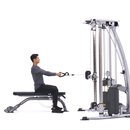
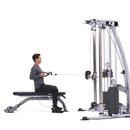
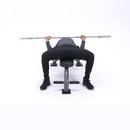
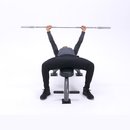






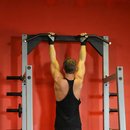
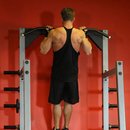
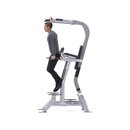
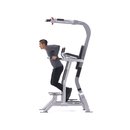
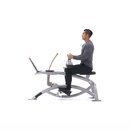
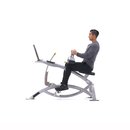
*Worth adding would be a set of partial repetitions. Partials are a great asset in the quest for mass.
Compare
How Does A Full-Body Workout Stack Up To The Standard 3, 4, And 5 Day Splits?
Full-body workouts consume less time, maximize muscle fiber stimulation, and trigger additional growth. The standard 3, 4 and 5 day splits don't traditionally don't compare due to solely employing 1-2 muscle groups per workout which equates to little muscle stimulation. Great bodybuilders (such as "The Oak", Mr. Arnold Schwarzenegger) used full-body workouts to achieve impressive physiques.
Benefits
What Are The Benefits Of A Full-Body Workout Routine?
Full-body workouts save time and stimulate the most muscle fibers every workout. The accentuated compound movements recruit multiple muscle groups than isolation exercises which therefore stimulates more muscle. Amplified muscle stimulation triggers more growth. Full-body workouts (from my personal experience and those of many others) have lead to great increases in size and strength.
Disadvantages
What Are The Disadvantages?
The only downside to full-body workouts is that one can utilize few exercises in terms of targeting specific muscle groups. Continual compound training may not be ideal for every circumstance. Isolation work can be useful when dealing with asymmetries where full-body type workouts may further exploit muscular appearance abnormalities and hinder bodybuilding goals due to aesthetics. However, isolation movements can be used in conjunction with a full-body routine near the end of a workout.
Bonus Question
Have You Ever Used A Full-Body Workout Routine? If So, How Were The Results?
I've used full-body workout routines not only when I started training but the majority of the time I've spent in the gym. I've found full-body routines delivered both my greatest strength and mass results in the shortest period of time when following a 50-second TUT protocol with moderate-heavy weight.
My results transformed my body from that of a chubby weakling to a formidable frame which I'm proud to have chiseled. I highly recommend full-body routines to anybody from beginners to the experienced since I believe everyone can benefit.



